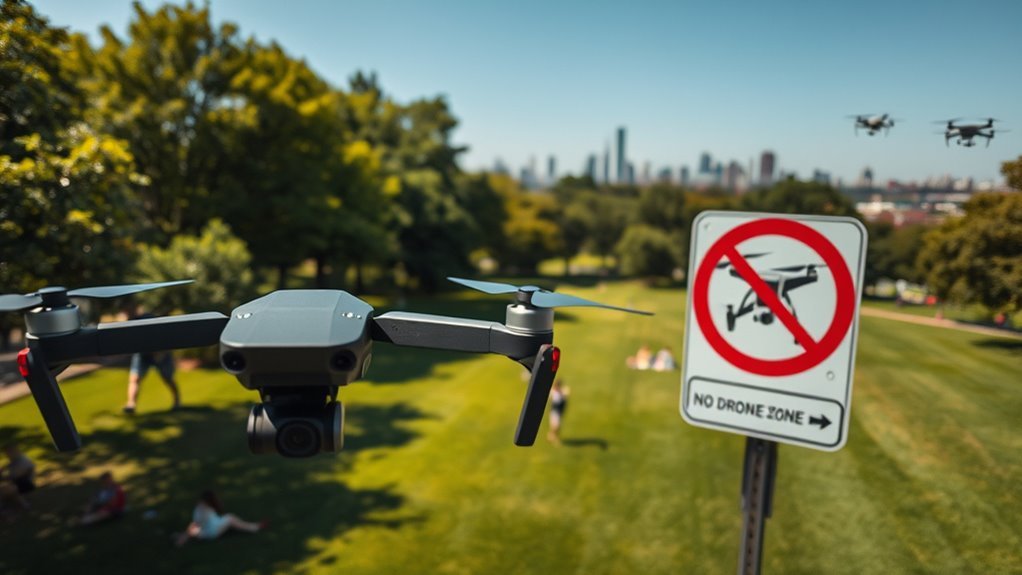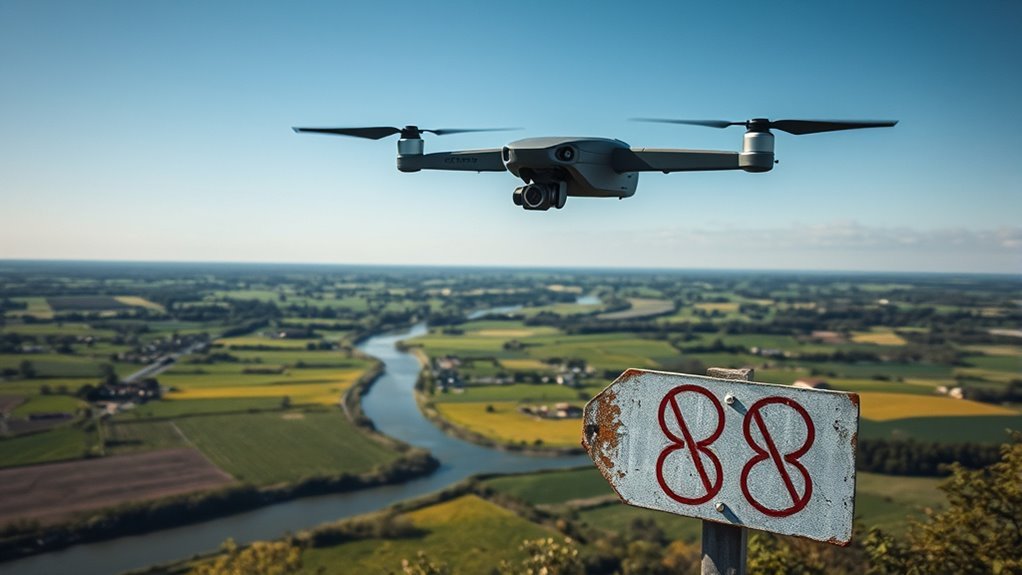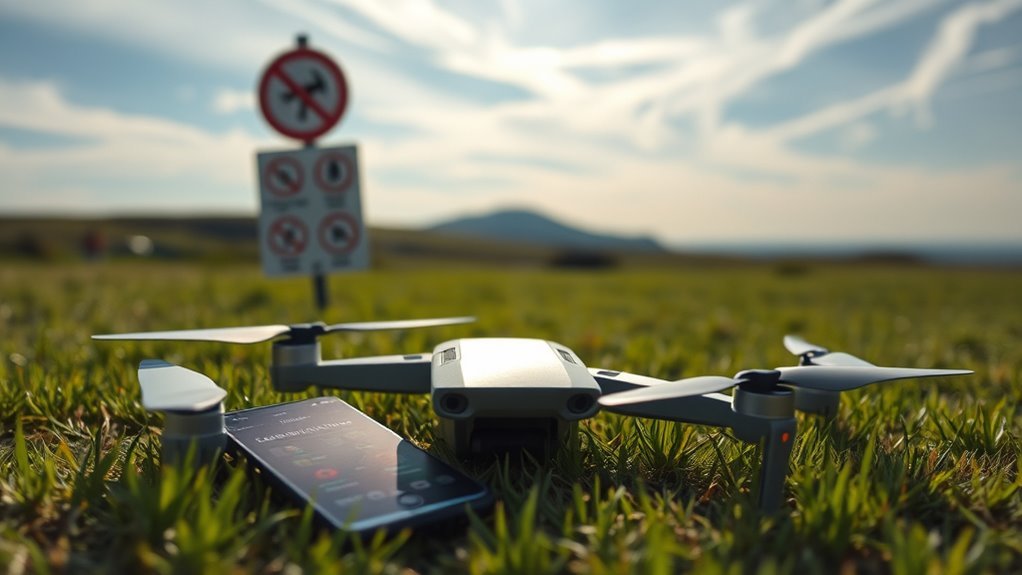To determine if drones are legal in the UK, you need to comply with Civil Aviation Authority (CAA) regulations. Verify your drone is registered if it weighs over 250g and you have the necessary Operator ID and Flyer ID. Familiarize yourself with airspace restrictions, privacy laws, and local regulations. Be aware of height limits and no-fly zones. Understanding these guidelines helps you operate legally and safely. Explore further to uncover more details on steering through drone regulations successfully.
Understanding Drone Regulations in the UK

When traversing the complex landscape of drone regulations in the UK, it’s essential to understand the legal framework governing their use. Compliance with these regulations guarantees drone safety, which is paramount for both operators and the public. You’ll need to familiarize yourself with the Civil Aviation Authority (CAA) guidelines, which dictate where and how drones can be operated. Additionally, obtaining suitable drone insurance is not just a wise choice; it’s often a requirement for commercial operators. This insurance protects you against potential liabilities arising from accidents or damage caused by your drone. By staying informed and adhering to these regulations, you can enjoy the freedom of flying your drone while minimizing risks and ensuring a safe environment for everyone.
Registration Requirements for Drone Pilots

To operate a drone legally in the UK, you must meet specific registration requirements set by the Civil Aviation Authority (CAA). This includes obtaining a drone registration number and ensuring proper pilot identification. Here’s a quick overview:
| Requirement | Details |
|---|---|
| Drone Registration | Mandatory for drones over 250g |
| Registration Fee | £9 annually |
| Pilot Identification | Obtain an Operator ID and Flyer ID |
| Age Requirement | Minimum age of 13 for registration |
| Training Courses | Recommended but not mandatory |
Categories of Drones and Their Classifications

Understanding the categories of drones is essential for compliance with UK regulations. You’ll find that drones are classified based on weight and purpose, which directly influences their registration and licensing requirements. Familiarizing yourself with these classifications will help you navigate the legal landscape effectively.
Drone Categories Overview
Drones can be classified into several categories based on their weight, purpose, and operational capabilities. Understanding these classifications is essential for maneuvering the landscape of drone legality in the UK, especially with drone technology advancements shaping how we perceive and use these devices. Here’s a quick overview of the primary categories:
- Recreational Drones: Designed for hobbyists and personal use, often subject to less stringent regulations.
- Commercial Drones: Utilized for business purposes, requiring adherence to strict drone safety measures.
- Industrial Drones: Employed in sectors like agriculture and construction, often equipped with advanced features for specialized tasks.
Knowing these categories helps you guarantee compliance with legal requirements while enjoying the freedom that drones offer.
Weight and Purpose Classification
While traversing the complexities of drone regulations in the UK, it is vital to recognize that drones are classified not only by their purpose but also by their weight. Understanding drone weight is important, as it determines the legal requirements for operation. Drones under 250 grams are often categorized as toy drones, suitable for recreational flight. Meanwhile, those weighing between 250 grams and 2 kilograms typically fall under the standard category, which may allow for commercial applications. Heavier drones, over 2 kilograms, are subject to stringent regulations due to their potential impact and flight purpose. By clearly understanding these classifications, you can navigate the legal landscape effectively and harness the freedom that responsible drone flying offers.
Registration and Licensing Requirements
With the classification of drones established, the next step is recognizing the registration and licensing requirements that correspond to each category. Understanding these requirements is essential for maintaining compliance while enjoying your freedom to fly.
- Drone Registration: All drones over 250 grams must be registered with the Civil Aviation Authority (CAA) before use.
- Licensing Process: Depending on your drone’s classification, you may need to complete an online competency test or obtain a specific license, like the PfCO for commercial use.
- Insurance: While not mandatory, having insurance is highly recommended to protect yourself against potential liabilities.
Airspace Restrictions and Zones
Understanding airspace restrictions and zones is essential for anyone operating a drone in the UK. You must familiarize yourself with airspace classifications, as they dictate where you can fly. Certain areas are designated as no fly zones, including near airports, military bases, and sensitive sites. These restrictions are enforced to guarantee safety and privacy, and violating them can result in hefty fines or legal action. You’ll find that airspace is divided into different classes—each with its own rules and limitations. By knowing these classifications, you can navigate the skies confidently while enjoying the freedom that drone flying offers. Always check local regulations and airspace maps before your flight to stay compliant and avoid potential issues.
Height Limitations for Drone Flights
When operating a drone in the UK, you must adhere to specific height limitations to guarantee compliance with aviation regulations. The maximum flight altitude is generally capped at 400 feet above ground level, unless you’re within a restricted airspace zone, where additional constraints may apply. Understanding these limitations is essential to avoid potential legal repercussions and guarantee safe operations.
Maximum Flight Altitude
Although flying a drone can be an exciting experience, it’s crucial to adhere to the maximum flight altitude regulations set by the UK Civil Aviation Authority (CAA). These regulations are in place to guarantee safety and prevent conflicts with manned aircraft.
Here are key points to remember about maximum flight altitude:
- You must not fly your drone above 120 meters (400 feet) vertically.
- Always maintain visual line-of-sight with your drone to manage its altitude effectively.
- Be aware of local laws and restrictions that may impose lower altitude limits.
Restricted Airspace Zones
Restricted airspace zones impose specific height limitations on drone flights to guarantee safety and security in sensitive areas. As a drone operator, you must be aware of these restrictions, especially when conducting drone mapping activities. No fly zones often include airports, military installations, and other vital infrastructures where flying above certain altitudes is prohibited. It’s essential to familiarize yourself with local airspace regulations to avoid violations that could lead to penalties. Before launching your drone, check the latest airspace maps and use apps designed for drone navigation to confirm compliance with height limitations. By respecting these restrictions, you can enjoy the freedom of flight while maintaining safety and legality. Always prioritize responsible flying within designated airspace boundaries.
Privacy Laws and Drone Usage
As drones become increasingly prevalent in both recreational and commercial contexts, understanding privacy laws surrounding their use is essential for operators. Drone privacy is a significant concern, particularly regarding surveillance issues that could infringe on individual rights. To navigate this complex landscape, consider these key points:
- Data Protection: Guarantee compliance with the UK’s Data Protection Act when capturing images or data.
- Consent: Obtain permission from individuals before filming or photographing them in private settings.
- Proximity: Maintain a respectful distance from private properties to avoid potential legal repercussions.
Local Laws and Ground-Level Restrictions
When operating a drone in the UK, you must comply with both national regulations and local airspace restrictions. Local laws can vary greatly, impacting where and how you can fly. It’s vital to understand these ground-level restrictions to guarantee your drone use is legal and safe.
National Drone Regulations
While maneuvering through the complex landscape of drone regulations in the UK, it’s essential to understand that local laws and ground-level restrictions can greatly impact where and how you can operate your drone. To guarantee you’re compliant, consider these key factors:
- Drone Insurance: Verify your drone insurance meets the specified requirements, as it can protect you against potential liabilities.
- Local Laws: Research specific local regulations that may limit drone usage in parks, residential areas, or near sensitive sites.
- Ground-Level Restrictions: Be aware of any restrictions regarding flying near buildings, crowds, or other obstacles that could pose safety risks.
Always stay informed about how drone technology evolves and aligns with these regulations to enjoy your flying experience responsibly.
Local Airspace Restrictions
Understanding local airspace restrictions is essential for ensuring safe and legal drone operations. Local flight restrictions can vary considerably based on regional airspace management policies, so it’s vital to familiarize yourself with them. Ignoring these regulations could lead to hefty fines or operational bans.
| Factor | Details |
|---|---|
| Prohibited Areas | Airports, military zones |
| Altitude Limits | Maximum height by location |
| Notification Zones | Areas requiring prior notice |
Stay informed about local laws and ground-level restrictions, as they can directly affect where and how you can fly your drone. This knowledge enables you to exercise your freedom responsibly while respecting airspace regulations.
Special Permissions and Exceptions
In situations where standard regulations may not suffice, drone operators in the UK can seek special permissions and exceptions to enhance their operational capabilities. These permissions enable you to conduct flights under specific conditions that would otherwise be restricted. You might consider pursuing:
- Special Use Airspace: For operations in controlled airspace where typical regulations apply.
- Event Permissions: For flying during gatherings or events where crowds are present, necessitating heightened safety measures.
- Night Operations: To operate drones during nighttime, which generally requires additional safety assessments.
Understanding these options allows you to expand your drone activities legally while maintaining safety standards. Always verify your requests are well-documented and justified to facilitate the approval process.
Penalties for Non-Compliance
Failing to comply with drone regulations in the UK can lead to severe penalties, which may include hefty fines, legal action, or even the loss of your operating permissions. Understanding these legal ramifications is essential for any drone operator seeking freedom in their aerial pursuits. Below is a summary of potential enforcement actions you might face:
| Penalty Type | Description |
|---|---|
| Fines | Monetary penalties based on severity |
| Legal Action | Prosecution for serious violations |
| Revocation of Permissions | Loss of drone operating privileges |
You must take these consequences seriously. Ignoring regulations can jeopardize your ability to fly freely, so stay informed and compliant to protect your rights as a drone operator.
Resources for Staying Informed on Drone Laws
How can you guarantee you’re up-to-date with the ever-evolving drone regulations in the UK? Staying informed is essential for responsible drone operation. Here are some effective online resources for reliable drone law updates:
- UK Civil Aviation Authority (CAA) – The CAA’s website provides official regulations and guidance for drone users.
- DroneSafe – This platform offers extensive resources, including maps of no-fly zones and safety guidelines.
- Drone Community Forums – Engaging with other enthusiasts can provide real-time insights and shared experiences regarding recent changes in laws.
Frequently Asked Questions
Are Recreational Drones Subject to the Same Regulations as Commercial Drones?
Recreational drones aren’t subject to the same commercial restrictions, but they must still adhere to specific recreational guidelines. Understanding these distinctions helps you enjoy flying while ensuring compliance with safety and legal requirements.
Can I Fly My Drone Near Airports or Military Bases?
Sure, you can fly your drone near airports or military bases—if you enjoy a hefty fine or worse! Airport restrictions and military no fly zones are serious. Always check regulations to avoid trouble.
What Are the Consequences of Flying a Drone Illegally?
Flying a drone illegally can lead to significant fines and penalties, along with legal repercussions like criminal charges. It is crucial to understand these risks to maintain your freedom and operate within the law responsibly.
Do I Need Insurance for Drone Operations in the UK?
So, you think flying your drone without insurance is a thrilling adventure? In reality, you need drone liability insurance coverage to protect yourself from potential mishaps, ensuring your freedom doesn’t come with hefty legal consequences.
How Can I Report a Drone-Related Incident or Violation?
To report a drone-related incident, you should follow established reporting procedures. Guarantee drone safety by documenting the event thoroughly and contacting local authorities or aviation regulators to address any violations and promote responsible drone use.

